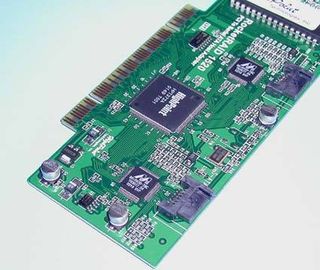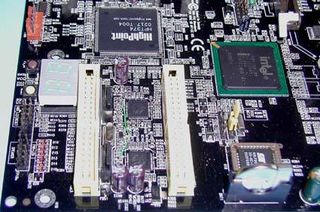Back To The Future: Serial ATA Arrives At Last
Serial ATA Controller: PCI Only

RocketRAID 1520 is the name of the latest serial ATA controller from HighPoint. It offers two channels, each of which controls one or two hard disks. Its technology is based on the model it replaces, which is not a problem for the user, as it offers drop-in compatibility.
Because its features make parallel ATA yesterday's technology, serial ATA will eventually become the de facto standard. An important feature of the new standard is that current ATA controller chips can be used simply by adding the appropriate components (bridges). This is a very cost-effective solution.
However, this elegant new standard does have its limitations. Serial ATA adapters use the PCI bus, which restricts the theoretical maximum data transfer rate of 150 MByte/s to the 133 MByte/s that the PCI bus allows. In practice, however, 100-110 MByte/s is rarely achieved using today's technology. Serial ATA will not be able to claim any performance advantage over UltraATA/100 or UltraATA/133 over the next few months. Even the next generation of hard disks will not come close to the maximum transfer rates. The only way of achieving this level of data transfer is to use more than one hard disk in a RAID array.

A detailed view of both connectors and the controller chip. Both bridges are clearly visible.
Do not expect Serial ATA to be integrated into chipsets until early 2003, when new chipsets and southbridges such as Intel's ICH5 and VIA's VT8236/8238 are introduced. Both, Intel's hub architecture and VIA's V-link, are basically nothing more than multiple, serial connections enabling bandwidths of 533 MByte/s with relatively few data lines. A Serial ATA controller will be able to achieve its full potential within these architectures, and integration should prove to be relatively straightforward.

ATA to SATA - Marvell converter. The connector is to the right of the device.
On-Board Solution: ABit IT7 MAX2 With Serial ATA

ABIT sent us the IT7-MAX2, which is fitted with two serial ATA connectors. This motherboard is based on the IT7-MAX, which made a name for itself by dispensing with PS/2, serial and parallel ports. On the MAX2, ABit has included ports for keyboard and mouse. Two Marvell bridges provide the serial ATA interface. These use two of the four IDE channels of the HighPoint HPT374 controller. The IT7-MAX2 can therefore handle eight conventional IDE devices, as well as two serial ATA devices. Unfortunately, all storage devices still have to share the 133 MByte/s bandwidth of the PCI bus.
Stay on the Cutting Edge
Join the experts who read Tom's Hardware for the inside track on enthusiast PC tech news — and have for over 25 years. We'll send breaking news and in-depth reviews of CPUs, GPUs, AI, maker hardware and more straight to your inbox.
Current page: Serial ATA Controller: PCI Only
Prev Page The Connections: Small And Hot-Pluggable Next Page Making The Switch - Adapters Make It PossibleMost Popular

